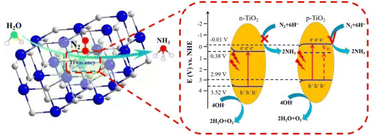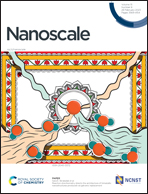Cationic vacancy engineering of p-TiO2 for enhanced photocatalytic nitrogen fixation†
Abstract
Defect engineering is one of the effective strategies to regulate and control catalyst properties. Constructing appropriate catalytically active centers effectively tunes the electronic and surface properties of the catalyst to achieve further enrichment of photogenerated electrons, enhances the electronic feedback of the catalytically active center to the anti-bonding orbitals of the nitrogen molecule, and enhances N2 adsorption while weakening the N![[triple bond, length as m-dash]](https://www.rsc.org/images/entities/char_e002.gif) N bond. In this study, titanium vacancy (VTi)-rich undoped anatase p-TiO2 was successfully synthesized to investigate the effect of its metal vacancies on photocatalytic nitrogen reduction reaction (NRR) performance. The cation vacancies of VTi-rich p-TiO2 lead to local charge defects that enhance carrier separation and transport while trapping electrons to activate N2, allowing effective reduction of the excited electrons to NH3. This work provides a viable strategy for driving the efficiency of photocatalytic nitrogen fixation processes by altering the structural properties of semiconductors through cationic vacancies, offering new opportunities and challenges for the design and preparation of titanium dioxide-based materials.
N bond. In this study, titanium vacancy (VTi)-rich undoped anatase p-TiO2 was successfully synthesized to investigate the effect of its metal vacancies on photocatalytic nitrogen reduction reaction (NRR) performance. The cation vacancies of VTi-rich p-TiO2 lead to local charge defects that enhance carrier separation and transport while trapping electrons to activate N2, allowing effective reduction of the excited electrons to NH3. This work provides a viable strategy for driving the efficiency of photocatalytic nitrogen fixation processes by altering the structural properties of semiconductors through cationic vacancies, offering new opportunities and challenges for the design and preparation of titanium dioxide-based materials.



 Please wait while we load your content...
Please wait while we load your content...